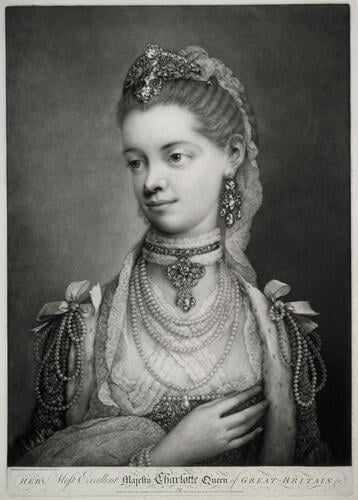-
1 of 253523 objects
Thomas Frye (1711/12-62)
HER Most Excellent Majesty Charlotte Queen of GREAT BRITAIN &c. 1762
Mezzotint with drypoint | 61.4 x 43.0 cm (platemark) | RCIN 604595

Thomas Frye (1711/12-62)
HER Most Excellent Majesty Charlotte Queen of GREAT BRITAIN &c 1762
-
This print provides an exceptional example of the print-making industry in London in the mid-eighteenth century. This portrait of the Queen is particularly valuable for the detail with which her splendid and plentiful jewellery is depicted; Vile’s jewel cabinet was made to house these magnificent jewels, also in 1762. Impressions of this print, or derivations from it, circulated widely in England in the early years of the reign.
Thomas Frye was one of the most successful mezzotinters of his era, as well as a portraitist in oil, pastel and miniature. William Pether, who also painted portraits in oils, was Frye’s pupil for a time before the two went into partnership together as engravers. Frye’s distinguishing contribution to the print market was a large series of life-size portrait heads, engraved after his own works. Pether made his name with bravura mezzotints after paintings by Rembrandt and Joseph Wright of Derby which relied upon dramatic contrasts between areas of shadow and illumination.
Frye, who was born in Ireland, had in 1741 painted a portrait of Frederick, Prince of Wales (Royal Collection). Over twenty years later his intention to make portraits of Queen Charlotte took him to the theatre; this was presumably the only place where Frye could observe her and hope to secure her likeness. It is said that the Queen, seeing the artist at work, obligingly turned her face towards him, in effect granting him an impromptu, informal sitting. The caption underneath the print which Frye and Pether produced after this portrait attests to this immediacy, boasting that it was made ad vivum, from the life.
The printis remarkable for the delicacy with which the face is represented. As well as the mezzotint technique, the tonal properties of which made it particularly suitable for portraiture, Frye and Pether have used drypoint for the detail, a technique in which the surface of the plate is scratched directly with an etching needle in order to produce fine, delicate lines; this is particularly evident in the jewels around the Queen’s neck. The velvety bloom of the ink shows that this is a fine early impression of the first state of the print, pulled before the printing surface of the copper plate became worn; it is highly probable that this print was presented to the Queen by Frye in acknowledgement of her generosity in posing.
Catalogue entry adapted from George III & Queen Charlotte: Patronage, Collecting and Court Taste, London, 2004 -
Creator(s)
(mezzotinter) -
Medium and techniques
Mezzotint with drypoint
Measurements
61.4 x 43.0 cm (platemark)
Category
Object type(s)
Other number(s)